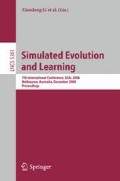Abstract
The inference of phylogenetic trees is one of the most important tasks in computational biology. In this paper, we propose an extension to multi-objective evolutionary algorithms to address this problem. Here, we adopt an enhanced indirect encoding for a tree using the corresponding Prüfer code represented in Newick format. The algorithm generates a range of non-dominated trees given alternative fitness measures such as statistical likelihood and maximum parsimony. A key feature of this approach is the preservation of the evolutionary hierarchy between species. Preliminary experimental results indicate that our model is capable of generating a set of optimized phylogenetic trees for given species data and the results are comparable with other techniques.
Access this chapter
Tax calculation will be finalised at checkout
Purchases are for personal use only
Preview
Unable to display preview. Download preview PDF.
References
Baldauf, S.L.: Phylogeny for the faint of heart: A tutorial. Trends in Genetics 19(6), 345–351 (2003)
Felsenstein, J.: PHYLIP – Phylogeny Inference Package (2000), http://evolution.genetics.washington.edu/phylip.html
Congdon, C.B., Septor, K.J.: Phylogenetic trees Using Evolutionary Search: Initial Progress in Extending Gaphyl to Work with Genetic Data. In: The 2003 Congress on Evolutionary Computation (CEC 2003), vol. 1, pp. 320–326 (December 2003)
Cancino, W., Delbem, A.C.B.: A Multi-Objective Evolutionary Approach for Phylogenetic Inference. In: Obayashi, S., Deb, K., Poloni, C., Hiroyasu, T., Murata, T. (eds.) EMO 2007. LNCS, vol. 4403, pp. 428–442. Springer, Heidelberg (2007)
Cotta, C., Moscato, P.: Inferring phylogenetic trees using evolutionary algorithms. In: Guervós, J.J.M., Adamidis, P.A., Beyer, H.-G., Fernández-Villacañas, J.-L., Schwefel, H.-P. (eds.) PPSN 2002. LNCS, vol. 2439, pp. 720–729. Springer, Heidelberg (2002)
Gottlieb, J., Julstrom, B.A., Raidl, G.R., Rothlauf, F.: Prüfer Numbers: A Poor Representation of Spanning Trees for Evolutionary Search. In: Spector, L., Goodman, E.D., Wu, A., Langdon, W.B., Voigt, H., Gen, M., Sen, S., Dorigo, M., Pezeshk, S., Garzon, M.H., Burke, E. (eds.) Proceedings of the Genetic and Evolutionary Computation Conference (GECCO 2001), pp. 343–350. Morgan Kaufmann, San Francisco (2001)
Gascuel, O.: BIONJ: an improved version of the NJ algorithm based on a simple model of sequence data. Molecular Biology and Evolution 14(7), 685–695 (1997)
Reijmers, T.H., Wehrens, R., Buydens, L.M.C.: Quality Criteria of Genetic Algorithms for Construction of Phylogenetic Trees. Journal of Computational Chemistry 20(8), 867–876 (1999)
Gen, M., Li, Y.: Spanning tree-based genetic algorithm for the bicriteria fixedcharge transportation problem. In: Proceedings of the 1999 Congress on Evolutionary Computation (CEC 1999), Washington, DC, USA, vol. 3, p. 2271 (1999)
Handl, J., Kell, D.B., Knowles, J.: Multiobjective Optimization in Bioinformatics and Computational Biology. IEEE/ACM Transaction on Computational Biology and Bioinformatics 4(2), 279–292 (2007)
Deb, K., Agarwal, S., Pratab, A., Meyarivan, T.: A Fast Elitist Non-Dominated Sorting Genetic Algorithm for Multi-Objective Optimization: NSGA-II. KanGAL report 2000001, Indian Institute of Technology, Kanpur, India (2000)
Zelwer, M., Daubin, V.: Detecting phylogenetic incongruence using BIONJ: an improvement of the ILD test. Molecular Phylogenetics and Evolution 33(3), 687–693 (2004)
Poladian, L., Jermiin, L.S.: Multi-objective evolutionary algorithms and phylogentic inference with multiple data sets. Soft Computing 10, 359–368 (2006)
Huelsenbeck, J.P., Ronquist, F.: MRBAYES: Bayesian inference of phylogenetic trees. Bioinformatics 17(8), 754–755 (2001)
Saitou, N., Nei, M.: The Neighbor-Joining Method: A New Method for reconstructing Phylogenetic Trees. Molecular Biology and Evolution 4(4), 406–425 (1987)
Takezaki, N., Nei, M.: Genetic distances and reconstruction of phylogenetic trees from microsatellite DNA. Genetics 144(1), 389–399 (1996)
Swofford, D., Olsen, G., Waddell, P., Hillis, D.: Phylogeny Reconstruction. In: Molecular Systematics, 3rd edn., pp. 407–514. Sinauer (1996)
Lewis, P.O.: A Genetic Algorithm for Maximum-Likelihood Phylogeny Inference Using Nucleotide Data. Molecular Biology and Evolution 15(3), 277–283 (1998)
Fitch, W.: Toward Difining the Course of Evolution: Minimum Change for a Specific Tree Topology. Systemetic Zoology 20(4), 406–416 (1972)
Felsenstein, J.: Evolutionary Trees from DNA Sequences: A Maximum Likelihood Approach. Journal of Molecular Evolution 17, 368–376 (1981)
Cole, J., Chai, B., Farris, R., Wang, K.S., McGarrell, D., Garrity, G., Tiedje, J.: The Ribosomal Database Project (RDP-II): Sequences and Tools for High-throughput rRNA Analysis. Nucleic Acids Research 33, D294–D296 (2005)
Ingman, M., Gyllensten, U.: mtDB: Human Mitochondrial Genome Database, a Resource for Population Genetics and Medical Sciences. Nucleic Acids Research 34, D749– D751 (2006)
Felsenstein, J.: DNAPARS – DNA Parsimony Program (1996), http://cmgm.stanford.edu/phylip/dnapars.html
Felsenstein, J.: DNAML – DNA Maximum Likelihood program (1993), http://cmgm.stanford.edu/phylip/dnaml.html
Author information
Authors and Affiliations
Editor information
Editors and Affiliations
Rights and permissions
Copyright information
© 2008 Springer-Verlag Berlin Heidelberg
About this paper
Cite this paper
Hassan, M.R., Hossain, M.M., Karmakar, C.K., Kirley, M. (2008). Phylogeny Inference Using a Multi-objective Evolutionary Algorithm with Indirect Representation. In: Li, X., et al. Simulated Evolution and Learning. SEAL 2008. Lecture Notes in Computer Science, vol 5361. Springer, Berlin, Heidelberg. https://doi.org/10.1007/978-3-540-89694-4_5
Download citation
DOI: https://doi.org/10.1007/978-3-540-89694-4_5
Publisher Name: Springer, Berlin, Heidelberg
Print ISBN: 978-3-540-89693-7
Online ISBN: 978-3-540-89694-4
eBook Packages: Computer ScienceComputer Science (R0)

